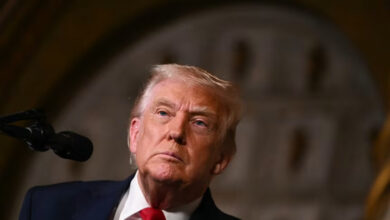
Ever since President Donald Trump introduced his first round of new tariffs, it’s been a waiting game to see just how much they’ll impact the global economy.
This week, one of the earliest signs was revealed — and it wasn’t pretty.
South Korea’s Customs Service reported that exports for the first 20 days of April declined by 5.2 percent compared to the same period last year. That singular data point is a “key bellwether” for where trade is heading, Min Joo Kang, a senior economist at ING, said in a note on Monday.
The decline in exports came after Trump enacted a 25 percent tariff on all aluminum, steel and auto imports. All other South Korean imports were also briefly subject to a 25 percent “reciprocal” tariff before Trump delayed it until July. Instead, imports from there are subject to a nearly universal 10 percent tariff.
That was evident in the data, which showed that car and steel shipments fell 6.5 percent and 8.7 percent, respectively, year over year for the first 20 days of April. Overall exports from South Korea to the US declined by 14.3 percent from last year.
The bright spot was semiconductor exports, which rose 10.2 percent compared to last April. Semiconductors remain exempt from US tariffs, but Trump has said he aims to implement tariffs as high as 25 percent on the product.
For now, the South Korean data suggests that “US tariffs are complicating global trade dynamics,” Kang said.
But things can often change on a month-to-month basis, so it might be too early to jump to any conclusions, cautioned Lee Branstetter, an economics and public policy professor at Carnegie Mellon University.
It is, however, “reasonable to attribute part of the export decline to the Trump-related disruptions in trade,” he told CNN.
Branstetter, who previously served as senior economist for international trade and investment on former President Barack Obama’s Council of Economic Advisers, said he expects forthcoming trade data from other American trade partners to paint a similar picture. But those changes might not show up as fast because it can take a while for new tariffs to manifest in trade data, he added.
Forthcoming trade data likely won’t be cut and dry
The chaos that’s ensued from Trump’s on-and-off tariffs makes it increasingly hard to draw firm conclusions from forthcoming trade data.
For starters, it’s possible that some countries’ data will show exports to the US increased this month as businesses sought to take advantage of the “reciprocal” tariff pause.
Another major factor at play is the overarching uncertainty from Trump’s trade policies. For instance, the president recently claimed he’s negotiating deals with other nations, which he said could be finalized in a matter of weeks. At the same time, he’s also threatened new tariffs.
That uncertainty could be causing businesses to pause international orders altogether. That means some countries’ exports could decline, said Branstetter. For instance, one toy company CNN spoke with earlier this month said it stopped ordering goods from China over fears tariffs will continue to rise.
The trade picture for South Korea and the US could change, however, if talks between the two nations are sucessful.
South Korean Finance Minister Choi Sang-mok and Trade Minister Ahn Duk-geun are set to meet with US Treasury Secretary Scott Bessent and US Trade Representative Jamieson Greer on Thursday. The Trump administration has said it wants to prioritize trade deals with allies like South Korea.






